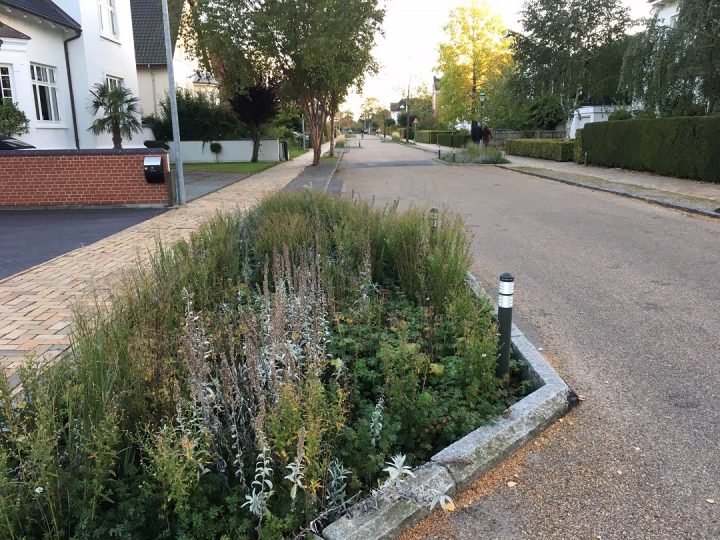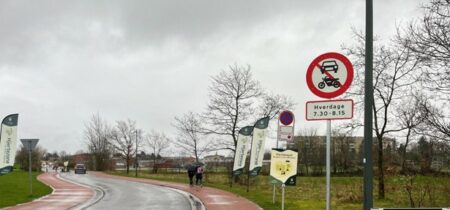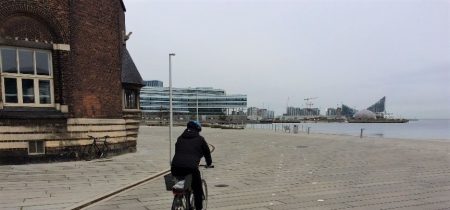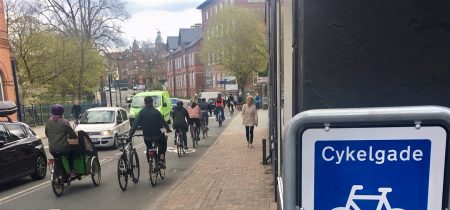Traffic calming
Traffic calming can reduce driving speeds so cycling next to cars is safe and secure. Good designs are available and have achieved excellent results. Speed bumps for cyclists can also be installed and car-free schools can be reinforced with signage.
By Troels Andersen
Traffic calming means limiting motor traffic in a given area, typically in order to reduce traffic accidents and promote security. The concept of traffic calming was written into the Danish Road Traffic Act§40 in 1976 with two types of traffic calming:
- Living street areas where the entire road area can be used for relaxation and play, and the dimensioning motor traffic speed is 15 km/h.
- Quiet road areas where the road continues to be used primarily for traffic, but which is dimensioned to a speed of 30 km/h out of consideration for weak road users’ safety.
In both cases it was a question of integrating road users with priority to weak road users. Later on traffic calming was extended to also apply on road stretches with higher speed limits. Speed bumps have been developed that can be used on stretches with bus traffic.
Traffic calming measures can be used including speed bumps, signed speed limits, road closures, one-way streets, traffic islands, roundabouts, shrubbery, etc. Speed reduction is the crucial factor for traffic safety. The number of accidents drops, and the accidents are less serious.
In practice, living streets are almost only established in new construction since the solution requires removal of existing pavements and laying down a new, continuous surface.
Traffic calming is of great benefit to cyclists, providing them with a greater sense of security and improved safety.
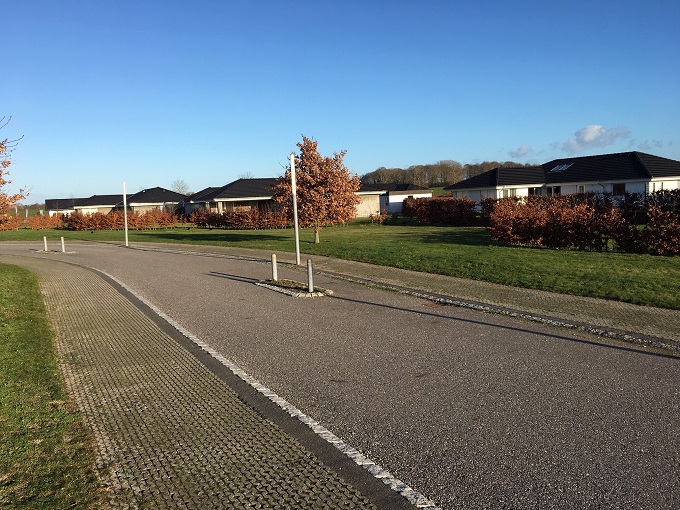
- This is how traffic calming should not be done. The staggering only works when two cars meet, and cyclists are squeezed. Photo Troels Andersen
Effects
A major assessment of more than 500 projects in the city of Copenhagen showed:
- Establishing quiet roads resulted in a 25-30% drop in the number of accidents and personal injury with fewer cross collisions and fewer pedestrian/parking accidents.
- A signal controlled F- intersection in urban areas improves traffic safety so the number of accidents and personal injuries drops by 30% in the signal controlled intersection and by 25% on the road leading up to the intersection. The safety of all road user groups is improved. Signal control of T-intersections and five legged intersections do affect traffic safety.
- Signal controlled pedestrian crossings have resulted in a 25-30% drop in the number of accidents and personal injuries. Cyclists and pedestrians experience the greatest safety improvement because the number of accidents on stretches and right of way intersections drops at a distance of up to 120-150 m. Safety benefits have only been found on roads with more than 10,000 cars per 24 hours.
Other Danish studies show that different types of traffic calming in urban areas result in a 20-38% drop in the number of accidents and personal injury.
The general effect of establishing speed bumps in urban areas can be calculated as follows:
All accidents -24%
Personal accidents -28%
Material accidents -20%
Personal injury -32%
Fatalities -56%
Serious -42%
Minor -26%
Establishing speed bumps will typically result in a motor traffic reduction of 25%.
Cyclist speed bumps
Normally cyclists should not be required to reduce speed, but it may be necessary in certain situations, for example at road works, events, etc. The Danish Road Directorate has tested several proposals for temporary traffic calming of cyclists:
- Black, mobile rumble strips
- Staggering the cycling area with N42 signs
- Pre-fabricated black/yellow bumps
- One skid-proof rubber mat with rumble effect
All test designs resulted in a significant reduction of average speed after passage. The measures that were most effective in reducing cycling speeds were bumps/rumble strips. The black/yellow prefabricated bumps are better than the black mobile rumble strips, and better than a single rubber mat.
Car free zones around schools
New measures for car free zones have been tested around a number of schools in Odense. They target parents who drop off and pick up their children by car since this creates dangerous and insecure situations for cycling and walking children as well as for other cyclists and pedestrians. Many schools experience chaotic situations every morning before the bell rings. Restrictions may be useful to protect the interests of vulnerable road users, and are usually only necessary within a given time limit.
Planners should focus on flexible solutions such as time limits and temporary restrictions. Temporary restrictions may be laid on parking or driving. Car free zones can also be installed for shorter periods or tested as a temporary measure. One local project was carried out in close cooperation with schools and the police including a focused information campaign targeting drivers.

- Car-free zones are simply a time limited prohibition for entering vehicles. Photo Troels Andersen
Car-free zones are a new measure that not many schools know about. School and school boards need to be informed of the principles and potential advantages of the new measure. Car-free zones have been established at three schools, and other schools are working on it. Car-free zones are a simple, cheap measure that can encourage more children and parents to walk and cycle.
Sources
Sikkerhedseffekter af trafiksanering og signalregulering i København, Trafitec


